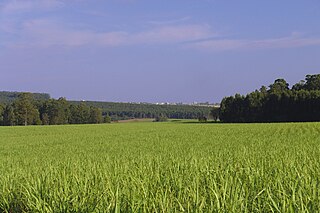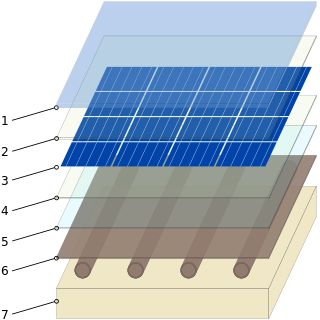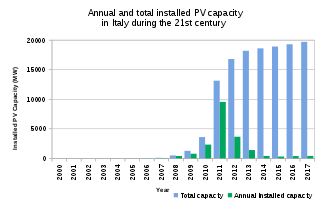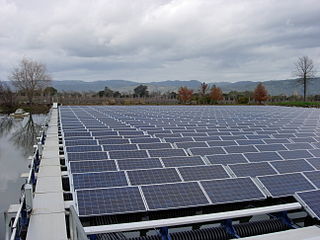
Renewable energy, green energy, or low-carbon energy is energy from renewable resources that are naturally replenished on a human timescale. Renewable resources include sunlight, wind, the movement of water, and geothermal heat. Although most renewable energy sources are sustainable, some are not. For example, some biomass sources are considered unsustainable at current rates of exploitation. Renewable energy is often used for electricity generation, heating and cooling. Renewable energy projects are typically large-scale, but they are also suited to rural and remote areas and developing countries, where energy is often crucial in human development.

Photovoltaics (PV) is the conversion of light into electricity using semiconducting materials that exhibit the photovoltaic effect, a phenomenon studied in physics, photochemistry, and electrochemistry. The photovoltaic effect is commercially used for electricity generation and as photosensors.

Bioenergy is a type of renewable energy that is derived from plants and animal waste. The biomass that is used as input materials consists of recently living organisms, mainly plants. Thus, fossil fuels are not regarded as biomass under this definition. Types of biomass commonly used for bioenergy include wood, food crops such as corn, energy crops and waste from forests, yards, or farms.

A solar panel is a device that converts sunlight into electricity by using photovoltaic (PV) cells. PV cells are made of materials that produce excited electrons when exposed to light. The electrons flow through a circuit and produce direct current (DC) electricity, which can be used to power various devices or be stored in batteries. Solar panels are also known as solar cell panels, solar electric panels, or PV modules.

Solar power is a fast-growing industry in Australia. As of September 2023, Australia's over 3.60 million solar PV installations had a combined capacity of 32.9 GW photovoltaic (PV) solar power, of which at least 3,823 MW were installed in the preceding 12 months. In 2019, 59 solar PV projects with a combined capacity of 2,881 MW were either under construction, constructed or due to start construction having reached financial closure. Solar accounted for 12.4% of Australia's total electrical energy production in 2021.

India's solar power installed capacity was 73.32 GWAC as of 31 December 2023.
For solar power, South Asia has the ideal combination of both high solar insolation and a high density of potential customers.

Solar power, also known as solar electricity, is the conversion of energy from sunlight into electricity, either directly using photovoltaics (PV) or indirectly using concentrated solar power. Solar panels use the photovoltaic effect to convert light into an electric current. Concentrated solar power systems use lenses or mirrors and solar tracking systems to focus a large area of sunlight to a hot spot, often to drive a steam turbine.
A photovoltaic system, also called a PV system or solar power system, is an electric power system designed to supply usable solar power by means of photovoltaics. It consists of an arrangement of several components, including solar panels to absorb and convert sunlight into electricity, a solar inverter to convert the output from direct to alternating current, as well as mounting, cabling, and other electrical accessories to set up a working system. It may also use a solar tracking system to improve the system's overall performance and include an integrated battery.

Cadmium telluride (CdTe) photovoltaics is a photovoltaic (PV) technology based on the use of cadmium telluride in a thin semiconductor layer designed to absorb and convert sunlight into electricity. Cadmium telluride PV is the only thin film technology with lower costs than conventional solar cells made of crystalline silicon in multi-kilowatt systems.

Photovoltaic thermal collectors, typically abbreviated as PVT collectors and also known as hybrid solar collectors, photovoltaic thermal solar collectors, PV/T collectors or solar cogeneration systems, are power generation technologies that convert solar radiation into usable thermal and electrical energy. PVT collectors combine photovoltaic solar cells, which convert sunlight into electricity, with a solar thermal collector, which transfers the otherwise unused waste heat from the PV module to a heat transfer fluid. By combining electricity and heat generation within the same component, these technologies can reach a higher overall efficiency than solar photovoltaic (PV) or solar thermal (T) alone.

Photovoltaic mounting systems are used to fix solar panels on surfaces like roofs, building facades, or the ground. These mounting systems generally enable retrofitting of solar panels on roofs or as part of the structure of the building. As the relative costs of solar photovoltaic (PV) modules has dropped, the costs of the racks have become more important and for small PV systems can be the most expensive material cost. This has caused an interest in small users deploying a DIY approach. Due to these trends, there has been an explosion of new racking trends. These include non-optimal orientations and tilt angles, new types of roof-mounts, ground mounts, canopies, building integrated, shading, vertical mounted and fencing systems.

Solar power is an important contributor to electricity generation in Italy, accounting for 8% of the total in 2017. As of 2022, the country has a total installed capacity of 22.56 GW. In 2019, Italy set a national goal of reaching 50 GW by 2030.

A photovoltaic power station, also known as a solar park, solar farm, or solar power plant, is a large-scale grid-connected photovoltaic power system designed for the supply of merchant power. They are different from most building-mounted and other decentralized solar power because they supply power at the utility level, rather than to a local user or users. Utility-scale solar is sometimes used to describe this type of project.

Solar power in Mexico has the potential to produce vast amounts of energy. 70% of the country has an insolation of greater than 4.5 kWh/m2/day. Using 15% efficient photovoltaics, a square 25 km (16 mi) on each side in the state of Chihuahua or the Sonoran Desert could supply all of Mexico's electricity.

The total installed solar power in Brazil was estimated at about 38.4 GW at February 2024, which consists of about 17.0% of the country's electricity matrix. In 2022, Brazil was the 8th country in the world in terms of installed solar power capacity.

While being a major oil producing country, the United Arab Emirates (UAE) has taken steps to introduce solar power on a large scale. However, solar power still accounts for a small share of energy production in the country. The country was the 6th top carbon dioxide emitter per capita in the world in 2009, with 40.31 tonnes, but is planning to generate half of its electrical energy by 2050 from solar and nuclear sources, targeting 44% renewables, 38% gas, 12% coal, and 6% nuclear energy sources.

Agrivoltaics,agrophotovoltaics,agrisolar, or dual-use solar is the simultaneous use of areas of land for both solar panels and agriculture. The technique was originally conceived by Adolf Goetzberger and Armin Zastrow in 1981, Agrivoltaics can refer to different methods of combining crops with solar panels, from conventional solar panels placed on top of crops, to greenhouses made of semi-transparent PV panels.

Renewable energy in South Africa is energy generated in South Africa from renewable resources, those that naturally replenish themselves—such as sunlight, wind, tides, waves, rain, biomass, and geothermal heat. Renewable energy focuses on four core areas: electricity generation, air and water heating/cooling, transportation, and rural energy services. The energy sector in South Africa is an important component of global energy regimes due to the country's innovation and advances in renewable energy. South Africa's greenhouse gas (GHG) emissions is ranked as moderate and its per capita emission rate is higher than the global average. Energy demand within the country is expected to rise steadily and double by 2025.

Floating solar or floating photovoltaics (FPV), sometimes called floatovoltaics, are solar panels mounted on a structure that floats on a body of water, typically a reservoir or a lake such as drinking water reservoirs, quarry lakes, irrigation canals or remediation and tailing ponds. A growing number of such systems exist in China, France, Indonesia, India, Japan, South Korea, the United Kingdom, Singapore, Thailand, and the United States.

















